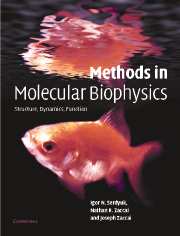Book contents
- Frontmatter
- Contents
- Foreword by D. M. Engelman
- Foreword by Pierre Joliot
- Preface
- Introduction: Molecular biophysics at the beginning of the twenty-first century: from ensemble measurements to single-molecule detection
- Part A Biological macromolecules and physical tools
- Part B Mass spectrometry
- Part C Thermodynamics
- Part D Hydrodynamics
- Part E Optical spectroscopy
- Part F Optical microscopy
- Chapter F1 Light microscopy
- Chapter F2 Atomic force microscopy
- Chapter F3 Fluorescence microscopy
- Chapter F4 Single-molecule detection
- Chapter F5 Single-molecule manipulation
- Part G X-ray and neutron diffraction
- Part H Electron diffraction
- Part I Molecular dynamics
- Part J Nuclear magnetic resonance
- References
- Index of eminent scientists
- Subject Index
- References
Chapter F2 - Atomic force microscopy
from Part F - Optical microscopy
Published online by Cambridge University Press: 05 November 2012
- Frontmatter
- Contents
- Foreword by D. M. Engelman
- Foreword by Pierre Joliot
- Preface
- Introduction: Molecular biophysics at the beginning of the twenty-first century: from ensemble measurements to single-molecule detection
- Part A Biological macromolecules and physical tools
- Part B Mass spectrometry
- Part C Thermodynamics
- Part D Hydrodynamics
- Part E Optical spectroscopy
- Part F Optical microscopy
- Chapter F1 Light microscopy
- Chapter F2 Atomic force microscopy
- Chapter F3 Fluorescence microscopy
- Chapter F4 Single-molecule detection
- Chapter F5 Single-molecule manipulation
- Part G X-ray and neutron diffraction
- Part H Electron diffraction
- Part I Molecular dynamics
- Part J Nuclear magnetic resonance
- References
- Index of eminent scientists
- Subject Index
- References
Summary
Historical review
Early 1980s
G. Binning and H. Rohrer proposed the scanning tunnelling microscope (for which they were awarded the Nobel Prize). This invention has initiated an exciting series of novel experiments to image the surface of conducting as well as insulating solids with atomic resolution. The first attempts at imaging biological molecules using a scanning tunnelling microscope (STM) date back to 1983. In 1987, individual molecules of phthalocyanine, lipid bilayers and ascorbic acid were reported. One year later, H. Ohtani with collaborators imaged benzene, the molecule of Kekul′e 's blue dream, as three-lobed rings. In 1989 a spectacular view of the double-stranded Z-DNA molecule, the first biological macromolecule studied using a STM, was presented.
1986
G. Binning, C. F. Quate and C. Gerber invented the scanning force microscope (SFM). In this microscope a sensor tip carried by a flexible cantilever is used to touch and characterise a surface. This was a significant breakthrough which allows biological macromolecules to be scanned in aqueous solution and gives reproducible imaging of DNA and of membrane protein crystals.
Early 1990s
D. J. Keller, Q. Zhong and C. A. J. Putman independently proposed the so-called tapping mode of the atomic force microscope (AFM), in which the cantilever is oscillated vertically while it is scanned over the sample. In this mode the image is formed by displaying the reduction of the oscillation amplitude at every point of the sample.
- Type
- Chapter
- Information
- Methods in Molecular BiophysicsStructure, Dynamics, Function, pp. 641 - 657Publisher: Cambridge University PressPrint publication year: 2007



